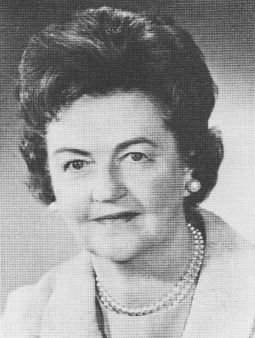History
Bernice Eddy Warned of Defective Salk Polio Vaccine
Published June 23, 2016 | Vaccination, History

Had
they listened to Dr. Eddy, 40,000 children would not have been infected
with polio, 200 would not have been severely paralyzed and 10 of them
would not have died.
During the Republican primary presidential debate on September 16, 2015, CNN moderator Jake Tapper noted a U.S. Treasury Department announcement that a woman would appear on the $10 bill. He posed the following question to the 11 candidates on stage, “What woman would you like to see on the $10 bill?”1
In response, the candidates mentioned eight women, including civil rights activist Rosa Parks, former First Lady Abigail Adams, suffragist Susan B. Anthony, American Red Cross founder Clara Barton, Mother Teresa of Calcutta, former British Prime Minister Margaret Thatcher, former Arkansas government Mike Huckabee’s wife, Janet, and former neurosurgeon Ben Carson’s mother, Sonya.2
Interesting choices. Another good choice for the $10 bill might have been Bernice Eddy, PhD. If you never heard of her, it’s not surprising. By all rights, though, Dr. Eddy should have been every bit as famous as any of the women mentioned above (aside from Janet Huckabee and Sonya Carson, of, course). Dr. Eddy was a key member of the team of scientists who developed the first injectable inactivated polio vaccine (IPV)—the vaccine associated with Jonas Salk, MD that earned him a photo on the cover of TIME magazine and made him an honored historical figure.3
Dr. Salk was the IPV team leader, and was credited with the development of the first polio vaccine, which was tested on 1.8 million children (the so-called “Polio Pioneers”) in the United States in 1954 and subsequently approved for widespread distribution and use in 1955.4
Dr. Eddy, who was with the National Institutes of Health (NIH), was the team’s vaccine safety tester. She is the person who in 1954-1955 discovered faulty batches of the Salk vaccine produced by Cutter Laboratories, Inc. of Berkeley, CA and warned her superiors at NIH about the problem, urging that the polio vaccine’s licensing be delayed.3 5 NIH director William Sebrell, however, ignored Dr. Eddy’s warning and moved to recommend the licensing of the Salk vaccine.6 7
Eddy stated that when she tested the Salk vaccine it caused severe paralysis in monkeys. She photographed the diseased monkeys, took these photos to her boss—and was reprimanded as an alarmist.3About 400,000 people—mostly schoolchildren—in the U.S. were vaccinated with the Salk/Cutter vaccine during mid-April 1955. More than 200,000 of these children were injected with vaccines “in which the process of inactivating the live virus proved to be defective.”8 In other words, the children were given vaccines containing live poliovirus, causing 40,000 of the children to come down with polio. The Salk/Cutter vaccines severely paralyzed 200 of these children and killed 10 of them.4
What happened is that the formaldehyde (a poison) used in the vaccine production process to kill the live poliovirus in the vaccines, which was supposed to make the polioviruses inactivate, did not do its job.3 (See “Formaldehyde: A Poison and Carcinogen” for information on the use of formaldehyde in vaccines.)
The scientists involved in the development, licensing and launch of the Salk vaccine in 1955 knew it posed a potential serious risk to children, but they opted to go ahead with fast tracking the vaccine to licensure just the same. Had they listened to Dr. Eddy, 40,000 children would not have been infected with polio, 200 would not have been severely paralyzed and 10 of them would not have died.
So what happened to Dr. Eddy? After she was proven to be right, NIH officials removed Dr. Eddy from her position as a polio researcher and re-assigned her to do research on influenza.3 9
The so-called “Cutter Incident” was downplayed by the U.S. government as a kind of anomaly, and even now it is not commonly known or popularly associated with the Salk polio vaccine lore. Highlighting Dr. Eddy and her warning may have negatively effected public confidence in the Salk vaccine and harmed the government’s efforts to promote the vaccine as the long-sought after magic cure for polio. So Dr. Eddy was quietly disassociated from the program, instead of being lauded for her exceptional scientific work and personal integrity. (Note: Dr. Eddy’s name would resurface in 1960 with her discovery of the cancer-causing SV-40 monkey virus found to have contaminated the original Salk and Sabin polio vaccines.)
The publicity surrounding the Cutter Incident was one reason why the U.S. government in 1963 chose to replace the Salk vaccine with the live oral polio vaccine (OPV) developed by Albert Sabin, MD. The Sabin vaccine was an attenuated (weakened) live poliovirus vaccine given orally and health officials also liked the fact that OPV passively “revaccinated” children and adults who came in close contact with children recently given live OPV.
Unfortunately, because the live attenuated poliovirus could be re-activated when passing through the gut, the Sabin vaccine also carried the risk of causing vaccine strain polio paralysis. A modified inactivated polio vaccine was re-introduced in 1999 in the U.S. after the only cases of polio were being caused by OPV vaccine.8
References


No comments:
Post a Comment